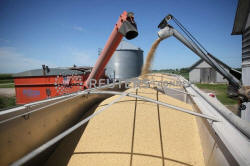U.S. soy exporters struggle with huge China export
commitments in midst of trade war
 Send a link to a friend
Send a link to a friend
 [June 04, 2019]
By Karl Plume [June 04, 2019]
By Karl Plume
CHICAGO (Reuters) - U.S. soybean exporters
are facing what may be their busiest and most logistically challenging
summer due to an unprecedented backlog of soybeans purchased by China
that still needs to be shipped and widespread floods in the U.S.
Midwest.
While there is little hope for a prompt U.S.-China trade deal, some 7
million tonnes of U.S. soybeans bought before talks broke down last
month will need to be delivered to Beijing in coming months, U.S.
exporters and industry analysts said.
China would face steep penalties if it tried to cancel the orders and,
as the world's top soy importer, it still needs the soybeans, traders
said. Cancellations of deals made during trade talks earlier this year
could also escalate diplomatic tensions.
"You have a contractual obligation so you're going to need a mutually
agreed-upon cancellation price or it would be considered default," said
a U.S.-based soy exporter who asked not to be named.

Cancellation costs would vary from seller to seller and could range from
hundreds of thousands to millions of dollars per cargo, depending on how
cheaply and easily the exporter can exit grain hedges and freight
commitments made when the initial purchase was made.
Chinese importers and U.S. exporters could instead try to renegotiate
contracts for delivery after September as the next U.S. harvest gets
underway. Otherwise, U.S. exporters still facing flood-related shipping
delays may seek to declare force majeure, traders said.
Delaying shipments to China until after the harvest would swell U.S. soy
stocks and push down prices, prolonging the financial pain on the U.S.
farm sector.
U.S. soybean stockpiles hit record highs this year as sales to China
fell to the lowest level in 16 years after Beijing imposed steep tariffs
on U.S. shipments in retaliation for U.S. duties on Chinese goods.
Chinese state-owned firms bought millions of tonnes of U.S. soybeans in
six waves of goodwill purchases from December to March, when hopes for a
trade deal were high. The firms typically bought more than 2 million
tonnes at a time from global grain traders.
The final two tranches of purchases on March 7 and March 28, totaling at
least 4 million tonnes for shipment from June to September, were part of
a 10-million-tonne purchase commitment made by Chinese negotiators
during trade talks in Washington.
[to top of second column] |

A trailer is filled with soybeans at a farm in Buda, Illinois, U.S.,
July 6, 2018. REUTERS/Daniel Acker/File Photo

Rising U.S. soybean export prices discouraged China from signing deals for the
rest of the purchase commitments before trade talks collapsed in May, one export
broker said. With relations deteriorating, additional purchases are not expected
anytime soon.
U.S. exporters have been loading an average of 4 to 5 China-bound cargo vessels
a week since January, and that pace is expected to begin ramping up this month
as Chinese purchases booked in March begin to ship.
HISTORIC FLOODING
U.S. exporters would need to load some 2.3 million tonnes of soybeans per month
through August to China ahead of the next U.S. harvest to meet their
commitments.
Over the past decade, U.S. soybean exports to all destinations have averaged
about 1.5 million tonnes a month in June, July and August, according to U.S.
government data. Chinese shipments have been less than 400,000 tonnes.
Adding to the challenge, historic flooding on the Mississippi River has impeded
operations at the largest U.S. grain shipping port in New Orleans and made
supplies from big sections of the Midwest farm belt largely inaccessible.
At least eight bulk cargo vessels were loading or waiting to load with
China-bound soy at three of the Gulf Coast's large export terminals last week,
according to a vessel lineup seen by Reuters.
The northern hemisphere summer is typically the slow season for U.S. soybean
exporters as South American soybeans are readily available for export. More than
three-quarters of all shipments normally depart the United States after the
harvest, from October and February.

"The clock is ticking, if they have to ship everything before August, and
logistics are not helping ... probably delivery can't be made on time," said a
senior soybean trader in Beijing.
(Reporting by Karl Plume in Chicago; Additional reporting by Dominique Patton in
Beijing; Editing by Caroline Stauffer and Sandra Maler)
[© 2019 Thomson Reuters. All rights
reserved.] Copyright 2019 Reuters. All rights reserved. This material may not be published,
broadcast, rewritten or redistributed.
Thompson Reuters is solely responsible for this content. |